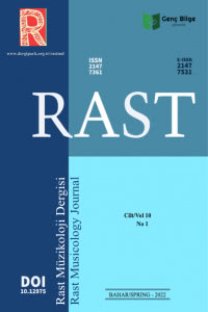Çağdaş dönem avangart trombon tekniklerinin kullanımı ve icrası üzerine bir analiz
20. yüzyıl, müzik anlayışının değiştiği, geliştiği aynı zamanda da farklı arayışlara gidildiği bir dönemdir. Klasik müzik, caz ve blues gibi birçok müzik türünde, enstrümanlar üzerinde farklı teknik denemeler ve çalışmalar yapılmaya başlanmıştır. Küreselleşme ve teknolojinin de gelişimi ile birlikte değişen ve gelişen müzik anlayışı ile birlikte birçok yeni çalışma ortaya çıkmış, besteciler eserlerinde fark yaratmak için popüler tekniklerin yanı sıra farklı ve sıra dışı yöntemler geliştirmiş, bunları deneme amaçlı eserlerinde kullanmışlardır. Müzik tarihinde klasik enstrümanların birçoğu için repertuvar yüzyıllara yayılarak, hemen her müzik döneminde yazılmış eserlere rastlanabilmektedir. Bununla birlikte, trombonun orkestraya diğer enstrümanlardan sonra eklenmiş olması ve yakın zamana kadar solo enstrüman olarak görülmemiş olması 20. yüzyıl öncesindeki müzik dönemlerinde kısıtlı bir trombon repertuvarı oluşmasına neden olmuştur. 20. yüzyıla kadar trombon repertuvarı az sayıda solo esere sahipken, 20. yüzyıldan itibaren solo enstrüman olarak kullanımının artmasıyla birlikte besteciler tarafından bu enstrümana çok sayıda eser yazılmıştır. 20. yüzyılın ikinci yarısında ise, trombon repertuvarında ve trombon tekniğinde aşağıdaki bölümlerde açıklanacağı üzere bir yön değişikliği yaşanmıştır. Teknolojinin gelişimi ile birlikte trombonun çalış limitlerini zorlayan besteciler artmış ve bu nedenle trombon üzerinde uygulanabilecek yeni teknikler ortaya çıkmıştır. Makalede 20. yüzyılın ikinci yarısında yazılmış eserler üzerinden “trombon ve ses”, “multifonik ve mikroton”, “trombon ve elektronik” başlıkları altında bir inceleme sunulacaktır. Ayrıca trombon sanat dalında kariyer arayan icracı ve eğitimcilerin modern solo trombon çalışmaları hakkında derinlemesine bilgi sahibi olmalarının avantajları değerlendirilerek yenilikçi eserlerin literatüre, eğitime ve müzikal kültüre olan katkıları incelenecektir.
Anahtar Kelimeler:
çağdaş müzik, mikroton, multifonik, müzik tarihi, trombon
An analysis on the use and performance of contemporary avant-garde trombone techniques
The 20th century was a period in which the understanding of music changed and developed, and at the same time sought different pursuits in music. In many musical genres such as classical music, jazz and blues, various technical, trials and studies have begun on instruments. Many new studies have emerged with the development of globalization and technology and the changing understanding of music. In the history of music, it is possible to come across many works written in almost every musical period for many instruments and a repertoire spanning centuries for them. Since trombone was added to the orchestra and was not viewed as a solo instrument until recently, only a limited repertoire for trombone was existed before the 20th century. In the second half of the 20th century, the advancement of technology allowed composers to challenge the limitations of the instrument; new trombone techniques and repertoire were created. In the article through the categories of “trombone and voice,” multi phonic and microtone,” and “trombone and electronics,” works written in the second half of the 20th century will be discussed. In addition, the article will also evaluate the advantages of trombone performers and educators with in-depth knowledge of modern solo trombone works, and examine the contributions of innovative works to literature, education and musical culture.
Keywords:
history of music, microtone, modern music, multiphonic, trombone,
___
- Apel, W. (1974). Harvard müzik sözlüğü (İkinci baskı). Cambridge, Massachusetts, ABD: Harvard University Press.
- Berger, A. A. (2017). Multidisciplinary perspectives on material culture. London: Roudledge.
- Büyüköztürk, Ş., Kılıç-Çakmak, E., Akgün, Ö., Karadeniz, Ş., & Demirel, F. (2008). Bilimsel araştırma yöntemleri. İstanbul: Pegem Akademi.
- Cage, J. (1960). Solo for sliding trombone. New York: Henmar Press inc.
- Cope, D. (1976). New music natition. Iowa, ABD: Kendall/Hunt Pub. Co
- Cox, T. B. (2011). Two Analyses and an Annotated List of Works for Solo Trombone with Electroacoustic Accompaniment for Use in the Collegiate Studio. Doktora tezi, University of Georgia.
- Cottington, D. (2013). The avant garde: a very short introduction. Oxford: Oxford University Press.
- Dempster, S. (1994). The modern trombone: a definition of its idioms. London: University of California Press.
- Duke, C. A. (2001). A Performer’s Guide to Theatrical Elements in Selected Trombone Literature. Doktora tezi, Louisiana State University.
- Guion, D. (2010). A history of the trombone. Lanham: Scarecrow Press.
- Gregory, R. (1973). The trombone: the instrument and its music. New York: Praeger.
- Hansen, N. C. (2010). Luciano Berio’s Sequenza V Analyzed along the Lines of Four Analytical Dimensions Proposed by the Composer. The Journal of Music and Meaning, 9 (Winter), 1-22
- Herbert, T. (2006). The trombone. London: Yale University Press.
- İlsayoğlu, E. (1994). Zaman içinde müzik. İstanbul: Yapı Kredi Yayınları.
- Sluchin, B. (1995). Practical introduction to contemporary trombone techniques. Paris: Editions Musicales Européennes.
- Webb, B. (2007). Richard Barrett’s ‘imaginary trombone. Contemporary Music Review, 26(2), 151-177. https://doi. org/10.1080/07494460701250882
- Wolfinbarger, S. (1983). “The Trombone Music of Arthur Pryor: Chapter II”. International Trombone Association, 11(2), 27-29.
- İnternet Kaynakları Cage, J. (2022). Solo for Sliding Trombone. Web sitesi: https://cageconcert.org/ performing-the-concert/orchestra/solo-for- sliding-trombone/
- Carnyx & Co. (2022). Dragon voices. Web sitesi: http://carnyx.org.uk/john-kenny/
- Jacob, V (2022). Jacobtv, Article and Interwiews. Web sitesi: https://www. jacobtv.net
- Kimbell, W. (2022). 20. yüzyıl trombon tarihi. Web sitesi: https://kimballtrombone. com/trombone-history-timeline/trombone- history-20th-century/
- ISSN: 2147-7361
- Yayın Aralığı: Yılda 4 Sayı
- Başlangıç: 2013
- Yayıncı: Genç Bilge Yayıncılık (Young Wise)
Sayıdaki Diğer Makaleler
Azerbaycan'daki düğün törenlerinin çeşitliliği bağlamında Nahçıvan bölgesinin düğün gelenekleri
Kosovo musicians' efficacy of using English language: Internationalization of Albanian songs
Teuta AGAJ AVDIU, Shqipe MORİNA, Arta TİKA BEKTESHİ, Besa BERİSHA
Nona NİKABADZE, Lile TANDILAVA, Maia BARAMIDZE
Music as an inclusion tool: can primary school teachers use it effectively?
Ardita DEVOLLİ, Shqipe AVDIU-KRYEZİU
Çağdaş dönem avangart trombon tekniklerinin kullanımı ve icrası üzerine bir analiz
